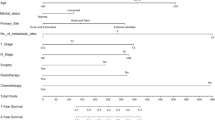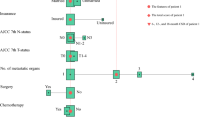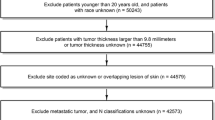Abstract
Purpose
This study aimed to assess the cumulative incidences of Non-melanoma skin cancer (NMSC)-specific mortality (NMSC-SM) and develop a competing risk nomogram for NMSC-SM.
Methods
Data on patients diagnosed with NMSC between 2010 and 2015 were extracted from the Surveillance, Epidemiology, and End Results (SEER) database. To identify the independent prognostic factors, univariate and multivariate competing risk models were used, and a competing risk model was constructed. Based on the model, we developed a competing risk nomogram to predict the 1-, 3-, 5-, and 8-year cumulative probabilities of NMSC-SM. The precision and ability to discriminate of the nomogram were evaluated through the utilization of metrics, such as receiver-operating characteristic (ROC) area under the curve (AUC), concordance index (C-index), and a calibration curve. Decision curve analysis (DCA) was employed to assess the clinical usefulness of the nomogram.
Results
Race, age, the primary site of the tumor, tumor grade, size, histological type, summary stage, stage group, order of radiation and surgery, and bone metastases were identified as independent risk factors. The prediction nomogram was constructed using the variables mentioned above. The ROC curves implied the good discrimination ability of the predictive model. The nomogram's C-index was 0.840 and 0.843 in the training and validation sets, respectively, and the calibration plots were well fitted. In addition, the competing risk nomogram demonstrated good clinical usefulness.
Conclusion
The competing risk nomogram displayed excellent discrimination and calibration for predicting NMSC-SM, which can be used in clinical contexts to help guide treatment decisions.






Similar content being viewed by others
Data availability
Data supporting the findings of this study are publicly available at the National Cancer Database and Surveillance, Epidemiology and End Results Program.
References
Aggarwal P, Knabel P, Fleischer AB Jr (2021) United States burden of melanoma and non-melanoma skin cancer from 1990 to 2019. J A Acad Dermatol 85:388–395. https://doi.org/10.1016/j.jaad.2021.03.109
Brantsch KD, Meisner C, Schönfisch B et al (2008) Analysis of risk factors determining prognosis of cutaneous squamous-cell carcinoma: a prospective study. Lancet Oncol 9:713–720. https://doi.org/10.1016/s1470-2045(08)70178-5
Bray F, Ferlay J, Soerjomataram I, Siegel RL, Torre LA, Jemal A (2018) Global cancer statistics 2018: GLOBOCAN estimates of incidence and mortality worldwide for 36 cancers in 185 countries. CA Cancer J Clin 68:394–424. https://doi.org/10.3322/caac.21492
Carmona R, Zakeri K, Green G et al (2016) Improved method to stratify elderly patients with cancer at risk for competing events. J Clin Oncol off J Am Soc Clin Oncol 34:1270–1277. https://doi.org/10.1200/jco.2015.65.0739
Cherpelis BS, Marcusen C, Lang PG (2002) Prognostic factors for metastasis in squamous cell carcinoma of the skin. Dermatol Surg 28:268–273. https://doi.org/10.1046/j.1524-4725.2002.01169.x
Demers AA, Nugent Z, Mihalcioiu C, Wiseman MC, Kliewer EV (2005) Trends of nonmelanoma skin cancer from 1960 through 2000 in a Canadian population. J Am Acad Dermatol 53:320–328. https://doi.org/10.1016/j.jaad.2005.03.043
Diffey BL, Langtry JA (2005) Skin cancer incidence and the ageing population. B J Dermatol 153:679–680. https://doi.org/10.1111/j.1365-2133.2005.06799.x
Dinehart SM, Peterson S (2005) Evaluation of the American Joint Committee on Cancer staging system for cutaneous squamous cell carcinoma and proposal of a new staging system. Dermatol Surg 31:1379–1384. https://doi.org/10.2310/6350.2005.31201
Fitzmaurice C, Abate D, Abbasi N et al (2019) Global, regional, and national cancer incidence, mortality, years of life lost, years lived with disability, and disability-adjusted life-years for 29 cancer groups, 1990 to 2017: a systematic analysis for the global burden of disease study. JAMA Oncol 5:1749–1768. https://doi.org/10.1001/jamaoncol.2019.2996
García-Pedrero JM, Martínez-Camblor P, Diaz-Coto S et al (2017) Tumor programmed cell death ligand 1 expression correlates with nodal metastasis in patients with cutaneous squamous cell carcinoma of the head and neck. J Am Acad Dermatol 77:527–533. https://doi.org/10.1016/j.jaad.2017.05.047
Griffin LL, Ali FR, Lear JT (2016) Non-melanoma skin cancer. Clin Med 16:62
Harrell FE Jr, Lee KL, Mark DB (1996) Multivariable prognostic models: issues in developing models, evaluating assumptions and adequacy, and measuring and reducing errors. Statist Med 15:361–387. https://doi.org/10.1002/(sici)1097-0258(19960229)15:4%3c361::Aid-sim168%3e3.0.Co;2-4
Holme SA, Malinovszky K, Roberts DL (2000) Changing trends in non-melanoma skin cancer in South Wales, 1988–98. Br J Dermatol 143:1224–1229. https://doi.org/10.1046/j.1365-2133.2000.03892.x
Iasonos A, Schrag D, Raj GV, Panageas KS (2008) How to build and interpret a nomogram for cancer prognosis. J Clin Oncol off J Am Soc Clin Oncol 26:1364–1370. https://doi.org/10.1200/jco.2007.12.9791
Larcher A, Trudeau V, Dell’Oglio P et al (2017) Prediction of competing mortality for decision-making between surgery or observation in elderly patients with T1 kidney cancer. Urology 102:130–137. https://doi.org/10.1016/j.urology.2016.08.069
Lemos BD, Storer BE, Iyer JG et al (2010) Pathologic nodal evaluation improves prognostic accuracy in Merkel cell carcinoma: analysis of 5823 cases as the basis of the first consensus staging system. J Am Acad Dermatol 63:751–761. https://doi.org/10.1016/j.jaad.2010.02.056
Li J, Li X, Gu J, Ma X, Xue F (2018) A competing-risks nomogram for predicting probability of death from CRC in Chinese Han patients with Stage I-III CRC. Jpn J Clin Oncol 48:1088–1095. https://doi.org/10.1093/jjco/hyy136
Lubov J, Labbé M, Sioufi K et al (2021) Prognostic factors of head and neck cutaneous squamous cell carcinoma: a systematic review. J Otolaryngol Head Neck Surg 50:54. https://doi.org/10.1186/s40463-021-00529-7
Luo X, Liu S, Chen Y et al (2021) Predicting cancer-specific mortality in patients with parotid gland carcinoma by competing risk nomogram. Head Neck 43:3888–3898. https://doi.org/10.1002/hed.26890
Madan V, Lear JT, Szeimies RM (2010) Non-melanoma skin cancer. Lancet 375:673–685
Motley R, Kersey P, Lawrence C (2002) Multiprofessional guidelines for the management of the patient with primary cutaneous squamous cell carcinoma. Br J Dermatol 146:18–25. https://doi.org/10.1046/j.0007-0963.2001.04615.x
Pintilie, M. Competing risks: a practical perspective. (John Wiley & Sons, 2006).
Pramana A, Browne L, Graham PH (2012) Metastatic cutaneous squamous cell carcinoma to parotid nodes: the role of bolus with adjuvant radiotherapy. J Med Imaging Radiat Oncol 56:100–108. https://doi.org/10.1111/j.1754-9485.2011.02326.x
Schmidt C, Martin JM, Khoo E, Plank A, Grigg R (2015) Outcomes of nodal metastatic cutaneous squamous cell carcinoma of the head and neck treated in a regional center. Head Neck 37:1808–1815. https://doi.org/10.1002/hed.23843
Schrama D, Peitsch WK, Zapatka M et al (2011) Merkel cell polyomavirus status is not associated with clinical course of Merkel cell carcinoma. J Investig Dermatol 131:1631–1638. https://doi.org/10.1038/jid.2011.115
Shen K, Yao L, Wei J et al (2019) Worse characteristics can predict survival effectively in bilateral primary breast cancer: a competing risk nomogram using the SEER database. Cancer Med. https://doi.org/10.1002/cam4.2662
Staples MP, Elwood M, Burton RC, Williams JL, Marks R, Giles GG (2006) Non-melanoma skin cancer in Australia: the 2002 national survey and trends since 1985. Med J Aust 184:6–10. https://doi.org/10.5694/j.1326-5377.2006.tb00086.x
Sweeny L, Zimmerman T, Carroll WR, Schmalbach CE, Day KE, Rosenthal EL (2014) Head and neck cutaneous squamous cell carcinoma requiring parotidectomy: prognostic indicators and treatment selection. Otolaryngol Head Neck Surg 150:610–617. https://doi.org/10.1177/0194599814520686
Väisänen JA, Alho OP, Koivunen PT, Läärä E (2018) Cause-specific mortality in patients with head and neck cancer: Long-term follow-up of a population-based cohort from 1986 to 2012 accounting for competing risks. Oral Oncol 79:20–26. https://doi.org/10.1016/j.oraloncology.2018.02.008
Veness MJ (2006) Defining patients with high-risk cutaneous squamous cell carcinoma. Australas J Dermatol 47:28–33. https://doi.org/10.1111/j.1440-0960.2006.00218.x
Veness MJ (2008) Time to rethink TNM staging in cutaneous SCC. Lancet Oncol 9:702–703. https://doi.org/10.1016/s1470-2045(08)70185-2
Vickers AJ, Cronin AM, Elkin EB, Gonen M (2008) Extensions to decision curve analysis, a novel method for evaluating diagnostic tests, prediction models and molecular markers. BMC Med Inform Decis Mak 8:53. https://doi.org/10.1186/1472-6947-8-53
Wang SB, Qi WX, Chen JY et al (2019) Competing risk nomogram predicting initial loco-regional recurrence in gastric cancer patients after D2 gastrectomy. Radiat Oncol (london, England) 14:128. https://doi.org/10.1186/s13014-019-1332-y
Whitney CA, Howard LE, Freedland SJ et al (2019) Impact of age, comorbidity, and PSA doubling time on long-term competing risks for mortality among men with non-metastatic castration-resistant prostate cancer. Prostate Cancer Prostatic Diseases 22:252–260. https://doi.org/10.1038/s41391-018-0095-0
Wu X, Elkin EE, Marghoob AA (2015) Burden of basal cell carcinoma in USA. Future Oncol (london, England) 11:2967–2974. https://doi.org/10.2217/fon.15.180
Acknowledgements
Not applicable.
Funding
This work was supported by grants from the National Science & Technology Fundamental Resources Investigation Program of China to L.Z. (No. 2018FY100900), the Hunan Provincial Natural Science Foundation of China Grant to Y.Z. (No. 2021JJ30923), the Provincial Science and Technology Innovation Leading Talents Project to L.Z. (No. 2021RC4014) and the Changsha Municipal Natural Science Foundation of China Grant to L.T. (No. kq2202022). The fund was not involved in any study design, data collection, analysis and interpretation, report writing, and article submission for publication.
Author information
Authors and Affiliations
Contributions
LT wrote the manuscript. YL, YZ, and LZ analyzed the data, YL and YZ provided professional comments to the manuscript. All authors have read and approved the final manuscript.
Corresponding author
Ethics declarations
Conflict of interest
The authors have no relevant financial or non-financial interests to disclose.
Ethical approval
Not applicable.
Consent to participate
Not applicable.
Consent to publish
Not applicable.
Additional information
Publisher's Note
Springer Nature remains neutral with regard to jurisdictional claims in published maps and institutional affiliations.
Supplementary Information
Below is the link to the electronic supplementary material.
Rights and permissions
Springer Nature or its licensor (e.g. a society or other partner) holds exclusive rights to this article under a publishing agreement with the author(s) or other rightsholder(s); author self-archiving of the accepted manuscript version of this article is solely governed by the terms of such publishing agreement and applicable law.
About this article
Cite this article
Tang, L., Zhang, L., Zeng, Y. et al. Competing risk nomogram for predicting cancer-specific mortality in patients with non-melanoma skin cancer. J Cancer Res Clin Oncol 149, 8817–8827 (2023). https://doi.org/10.1007/s00432-023-04826-8
Received:
Accepted:
Published:
Issue Date:
DOI: https://doi.org/10.1007/s00432-023-04826-8




